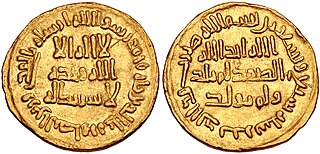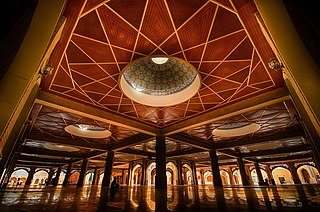Related Research Articles
The Kharijites were an Islamic sect which emerged during the First Fitna (656–661). The first Kharijites were supporters of Ali who rebelled against his acceptance of arbitration talks to settle the conflict with his challenger, Mu'awiya, at the Battle of Siffin in 657. They asserted that "judgment belongs to God alone," which became their motto, and that rebels such as Mu'awiya had to be fought and overcome according to Qur'anic injunctions. Ali defeated the Kharijites at the Battle of Nahrawan in 658, but their insurrection continued. Ali was assassinated in 661 by a Kharijite dissident seeking revenge for the defeat at Nahrawan.

Abu Muhammad al-Hajjaj ibn Yusuf ibn al-Hakam ibn Abi Aqil al-Thaqafi, known simply as al-Hajjaj ibn Yusuf, was the most notable governor who served the Umayyad Caliphate. He began his service under Caliph Abd al-Malik, who successively promoted him as the head of the Caliph's shurta, the governor of the Hejaz in 692–694, and the practical viceroy of a unified Iraqi province and the eastern parts of the Caliphate in 694. Al-Hajjaj retained the last post under Abd al-Malik's son and successor al-Walid I, whose decision-making was heavily influenced by al-Hajjaj, until his death in 714.

Sulayman ibn Abd al-Malik ibn Marwan was the seventh Umayyad caliph, ruling from 715 until his death. He was the son of Caliph Abd al-Malik ibn Marwan (r. 685–705) and Wallada bint al-Abbas. He began his career as governor of Palestine, while his father Abd al-Malik and brother al-Walid I reigned as caliphs. There, the theologian Raja ibn Haywa al-Kindi mentored him, and he forged close ties with Yazid ibn al-Muhallab, a major opponent of al-Hajjaj ibn Yusuf, al-Walid's powerful viceroy of Iraq and the eastern Caliphate. Sulayman resented al-Hajjaj's influence over his brother. As governor, Sulayman founded the city of Ramla and built the White Mosque in it. The new city superseded Lydda as the district capital of Palestine. Lydda was at least partly destroyed and its inhabitants may have been forcibly relocated to Ramla, which developed into an economic hub, became home to many Muslim scholars, and remained the commercial and administrative center of Palestine until the 11th century.

Kufa, also spelled Kufah, is a city in Iraq, about 170 kilometres (110 mi) south of Baghdad, and 10 kilometres (6.2 mi) northeast of Najaf. It is located on the banks of the Euphrates River. The estimated population in 2003 was 110,000. Currently, Kufa and Najaf are joined into a single urban area that is mostly commonly known to the outside world as 'Najaf'.

Abu al-Mughira Ziyad ibn Abihi, also known as Ziyad ibn Abi Sufyan, was an administrator and statesman of the successive Rashidun and Umayyad caliphates in the mid-7th century. He served as the governor of Basra in 665–670 and ultimately the first governor of Iraq and practical viceroy of the eastern Caliphate between 670 and his death.

Samura ibn Jundab al-Fazārī was a companion of the Islamic prophet Muhammad who fought at the Battle of Uhud in 627 and later participated in the Muslim conquest of Iran in the 630s–640s. In 670–673 he served as the lieutenant governor of Basra under Ziyad ibn Abihi, the supreme governor of Iraq and the eastern Umayyad Caliphate. During his deputy rule over Basra, he is held by the Islamic traditional sources to have ordered wide-scale executions of Kharijites in his jurisdiction. He remained governor of Basra under the Umayyad caliph Mu'awiya I for six to eighteen months after Ziyad's death in August/September 673 until the Caliph replaced him.
Yazid ibn al-Muhallab al-Azdi was a commander and statesman for the Umayyad Caliphate in Iraq and Khurasan in the early 8th century. In 720, he led the last of a series of wide scale Iraqi rebellions against the Umayyads.

Abū Saʿīd al-Muhallab ibn Abī Ṣufra al-Azdī was an Arab general from the Azd tribe who fought in the service of the Rashidun, Umayyad and Zubayrid caliphs between the mid-640s and his death. He served successive terms as the governor of Fars (685–686), Mosul, Arminiya and Adharbayjan (687–688) and Khurasan (698–702). Al-Muhallab's descendants, known as the Muhallabids, became a highly influential family, many of whose members held high office under various Umayyad and Abbasid caliphs, or became well-known scholars.

The Third Fitna, was a series of civil wars and uprisings against the Umayyad Caliphate. It began with a revolt against Caliph al-Walid II in 744, and lasted until 747, when Marwan II emerged as the victor. The war exacerbated internal tensions, especially the Qays–Yaman rivalry, and the temporary collapse of Umayyad authority opened the way for Kharijite and other anti-Umayyad revolts. The last and most successful of these was the Abbasid Revolution, which began in Khurasan in 747, and ended with the overthrow of the Umayyad Caliphate and the establishment of the Abbasid Caliphate in 750.
Sind was an administrative division of the Umayyad Caliphate and later of the Abbasid Caliphate in post-classical India, from around 711 CE with the Umayyad conquest of Sindh by the Arab military commander Muhammad ibn al-Qasim, to around 854 CE with the emergence of the independent dynasties of the Habbarid Emirate in Sindh proper and the Emirate of Multan in Punjab. The "Governor of Sind" was an official who administered the caliphal province over what are now Sindh, southern Punjab and Makran (Balochistan) in Pakistan.
Abd al-Rahman ibn Muhammad ibn al-Ash'ath, commonly known as Ibn al-Ash'ath after his grandfather, was a prominent Arab nobleman and military commander during the Umayyad Caliphate, most notable for leading a failed rebellion against the Umayyad viceroy of the east, al-Hajjaj ibn Yusuf, in 700–703.

ʿAbd Allāh ibn Khāzim al-Sulamī was the Umayyad governor of Khurasan between 662 and 665 and again in late 683, before becoming the nominal Zubayrid governor of the same province between 684 and his death.
ʿAbbād ibn Ziyād ibn Abīhi was an Arab commander and statesman of the Umayyad Caliphate. A son of the governor of Iraq, Ziyad ibn Abihi, Abbad served as a governor of Sijistan between 673 and 681 under caliphs Mu'awiya I and Yazid I. He led a contingent in the army of Caliph Marwan I at the Battle of Marj Rahit and afterward fought against loyalists of al-Mukhtar al-Thaqafi during the reign of Caliph Abd al-Malik. He later served at the court of the latter's son and successor, Caliph al-Walid I, and played a role in the succession intrigues between al-Walid's son Abd al-Aziz and the caliph's brother, Sulayman.

Abū Ḥarb Salm ibn Ziyād ibn Abīhi was a general and statesman of the Umayyad Caliphate, who later defected to the caliphate of Abd Allah ibn al-Zubayr during the Second Muslim Civil War before returning to the Umayyads' ranks. Salm was appointed by Caliph Yazid I as the governor of Khurasan and Sijistan in 681. During the course of his governorship, he launched several expeditionary raids into the Central Asian regions of Transoxiana, including Samarkand, and Khwarazm. His successes and generous distribution of war booty among his Khurasani Arab troops gained him wide popularity with them, but after Yazid died, Salm was not able to maintain their loyalty to the Umayyads for long. After his troops and chosen successor, Abd Allah ibn Khazim al-Sulami, gave their allegiance to the rival caliphate of Abd Allah ibn al-Zubayr, Salm made for Basra. There, he ultimately joined Ibn al-Zubayr's camp, but was imprisoned in Mecca by the latter nonetheless. After paying a large bribe, he was released and following Ibn al-Zubayr's death at the hands of the Umayyads in late 692, he was reappointed the governor of Khurasan. However, he died before he could resume his duties.
ʿAbd al-Raḥmān ibn Ziyād ibn Abīhi was the Umayyad governor of Khurasan in 678/79–681. He is credited for reasserting Umayyad authority over the Arab tribesmen who garrisoned the province and ensuring the flow of Khurasan’s revenues and tribute to the Umayyad treasury in Damascus.
Abū al-Qāsim Muḥammad ibn al-Ash'ath ibn Qays al-Kindī was the chieftain of the Kinda tribe in Kufa, succeeding his father al-Ash'ath ibn Qays. He served as governor of Tabaristan under the Umayyad viceroy of Iraq, Ubayd Allah ibn Ziyad and later as the governor of Mosul under the anti-Umayyad caliph Abd Allah ibn al-Zubayr. He died fighting for the latter's brother and governor of Iraq, Mus'ab ibn al-Zubayr, against the pro-Alid ruler of Kufa, Mukhtar al-Thaqafi, at the Battle of Harura in 686.
Ghalib ibn Abd Allah al-Laythi also known as Ghalib ibn Fadala al-Laythi, was an early companion and commander of the Islamic prophet Muhammad. During the prophet's lifetime, he led several expeditions against the polytheistic Bedouin tribes. He later participated in the conquest of Iraq in 634–636 and briefly as a commander in Khurasan in 668–671.
Amr ibn Hurayth ibn Amr ibn Uthman al-Makhzumi was a prominent member of the Quraysh in Kufa and the deputy governor of the city under the Umayyad governors of Iraq Ziyad ibn Abihi (670–673), Ubayd Allah ibn Ziyad (675–683) and Bishr ibn Marwan (692–694).
Qays ibn al-Haytham al-Sulamī was an Arab commander and administrator in the service of the Rashidun, Umayyad and Zubayrid caliphates. Under the caliphs Uthman and Mu'awiya I he served at time as the sub-governor of Khurasan and the cities of Nishapur and Marw al-Rudh. He was from a prominent Arab family in Basra and was a leader among the tribal nobility of that city until his death after 684.
Al-Hakam ibn Amr al-Ghifari, was a companion of the Islamic prophet Muhammad and the Umayyad governor of Khurasan and commander of Arab expeditions into Transoxiana from 665 until his death in Merv.
References
- Al-Askar, Abdullah. Al-Yamama in the Early Islamic Era. Reading, UK: Ithaca Press, 2002. ISBN 0-86372-400-0
- Blankinship, Khalid Yahya (1994). The End of the Jihâd State: The Reign of Hishām ibn ʻAbd al-Malik and the Collapse of the Umayyads. Albany, New York: State University of New York Press. ISBN 978-0-7914-1827-7.
- Crone, Patricia (1980). Slaves on Horses: The Evolution of the Islamic Polity. Cambridge: Cambridge University Press. ISBN 0-521-52940-9.
- Djaït, Hichem. Al-Kufa: Naissance de la Ville Islamique. Paris: Maisonneuve et Larose, 1986. ISBN 2-7068-0927-2
- The Encyclopaedia of Islam. New Ed. 12 vols. with supplement and indices. Leiden: E.J. Brill, 1960–2005.
- Kennedy, Hugh. The Early Abbasid Caliphate: A Political History. London: Croom Helm, 1981. ISBN 0-389-20018-2
- Le Strange, Guy (1905). The Lands of the Eastern Caliphate: Mesopotamia, Persia, and Central Asia, from the Moslem Conquest to the Time of Timur. New York: Barnes & Noble, Inc. OCLC 1044046.
- Morony, Michael G. (1984). Iraq after the Muslim Conquest. Princeton, New Jersey: Princeton University Press. ISBN 0-691-05395-2.
- Al-Rawas, Isam. Oman in Early Islamic History. Reading, UK: Garnet Publishing Limited, 2000. ISBN 0-86372-238-5
- Shaban, M. A. The 'Abbasid Revolution. Cambridge, UK: Cambridge University Press, 1970. ISBN 0-521-07849-0
- Yarshater, Ehsan, ed. (1985–2007). The History of al-Ṭabarī (40 vols). SUNY Series in Near Eastern Studies. Albany, New York: State University of New York Press. ISBN 978-0-7914-7249-1.